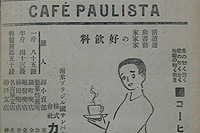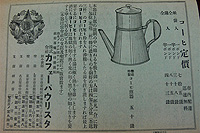Cafe Paulista and the Granted Coffee
Coffee, the money-bearing tree of which emigrants onboard the ship Kasato-maru and becoming colonos (contracted laborers) dreamt. They said that, drinking bitter coffee for the first time, they feared that they might have made a long voyage across oceans to grow such bitter stuff.
For Japanese people, Brazilian coffee is so familiar that they can associate Brazil with coffee. Brazil is the leading producer of coffee in the world, accounting for over 30% of the world’s production and changes in crop yileds in Brazil have a great influence on international coffee prices. Japan is now the third largest importer of coffee in the world, sitting behind the U.S. and Germany. In recent years, Brazil, Colombia and Indonesia became the major coffee exporters to Japan, accounting for 60% of all coffee imports. Among them Brazil is the largest exporter, accounting for 30%. Brazil itself is also a major consumer of coffee, and Japan is already the fourth largest consumer of the grain in the world (according to the statistics from the All Japan Coffee Association). The consumption trends of preferred beverages such as green tea, black tea and carbonated beverages show that the consumption of roasted ground coffee had surpassed that of green tea by mid-1975, and thereafter the consumption of coffee beverages has increased steadily with the rise in popularity of canned coffee drinks.
Not until 1913 annual coffee imports surpassed 100 tons, and increased to 1,057 tons in 1926; they had increased ten times for the years of the Taisho Era. One reason for the increase in consumption of cofee was the westernization of dietary habits among ordinary Japanese people from the Meiji Era (1868-1912) onwards until the Taisho (1912-1926) Era, which was demonstrated by the fact that "Shokudoraku", a book on gourmet western cuisine by Murai Gensai sold well. Another reason was that when western-style cafes and tea shops were opened one after another, Ryo Mizuno opened "the Cafe Paulista" in which coffee was served at a lower price than in western-style cafes and shops. Brazilian coffee appeared in the Japan Customs Statistics in 1916, when the ratio of Brazilian coffee to Java coffee was 43.6% to 0.5%. The first bags of coffee which the Government of of Sao Paulo State provided Ryo Mizuno gratis reached Japan in 1912, but the ratio of Brazilian coffee to Java coffee from 1912 until 1915 is not known. The predominance of Brazilian coffee over Java coffee had continued until 1922, the year before which the agreement for gratuitous provisions of coffee expired. The coffee which the Sao Paulo State Government provided gratis Mizuno for his contribution to the emigration on board the ship Kasato-maru and the setback in his emigration business, was dubbed "Granted Coffee by him. Mizuno used this "Granted Coffee" to open the "Cafe Paulista" in Ginza as well as then in cities across the country and even in Shanghai, to advertise Brazilian coffee and expand the sales of it, finally opening 23 shops in total. The "Granted Coffee" as a result of the emigration on board the ship Kasato-maru by Muzuno, and the "Cafe Paulista" which served inexpensive coffee and affordable light meals laid the foundation in the Taisho Era for the development of coffee market and the training of coffee specialists in Japan.
Today, you can, however, find elaborately designed cafes and vending machines on streets across the country from which you can buy your favorite coffee beverages. It is useless to think what might have become of coffee in Japan if not for the "Granted Coffee" from Brazil. 100 years have passed since on board the ship Kasato-maru emigration to Brazil.









